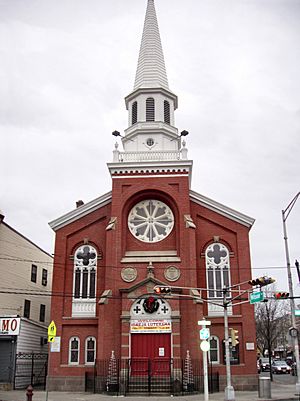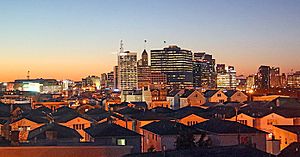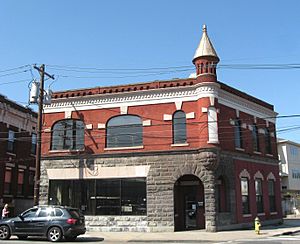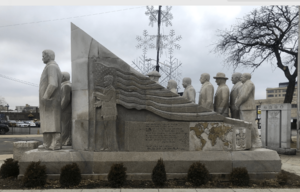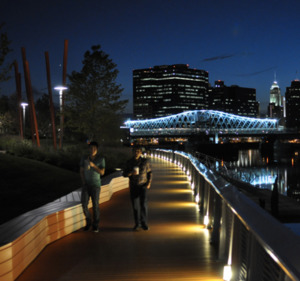The Ironbound facts for kids
The Ironbound is a lively neighborhood in the city of Newark, located in Essex County, New Jersey. It's a big community where many different cultures live and work together. The area covers about 4 square miles (10 square kilometers). Long ago, people called it "Dutch Neck," "Down Neck," or "the Neck" because it sits on a bend of the Passaic River. The Ironbound is part of Newark's East Ward. It's found just east of Newark Penn Station and Downtown Newark, and south and west of the river. You can cross the Jackson Street Bridge over the river to reach the towns of Harrison and Kearny.
Contents
How the Ironbound Began
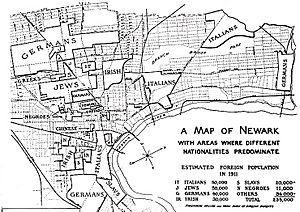
This area was mostly farms until the 1830s. That's when factories and new people moving in (immigrants) started to grow very quickly.
The name "The Ironbound" likely comes from two things. It could be because of the many factories that worked with metal in the area. Or, it might be from all the railroad tracks that surrounded the neighborhood like an iron fence.
Factories and Jobs
In the 1800s and early 1900s, the Ironbound was a busy place for factories. It was home to famous breweries like Hensler's Beer Brewery and P. Ballantine and Sons Brewing Company. Ballantine was Newark's biggest employer in 1954! The Feigenspan Brewery was also here.
The Balbach Smelting & Refining Company was once the second-largest metal processing company in the United States. It closed in the 1920s, and now Riverbank Park is in its place. Other large factories included Murphy Varnish Works.
Waves of Newcomers
The Ironbound has welcomed many different groups of immigrants over the years. The first big wave started in the 1830s, with people coming from German states. Soon, large parts of the Ironbound became home to Irish and German families.
Later in the 1800s, Polish and Italian immigrants arrived. Then, starting in the 1910s, many Portuguese and Spanish people moved in. By 1921, there were enough Portuguese people to start Sport Club Portuguese. This was the first of more than twenty Portuguese social clubs that would open in the Ironbound.
Historic Places to See
Several important places in the Ironbound are listed on the National Register of Historic Places. This means they are protected because of their history:
- Murphy Varnish Works
- Pennsylvania Station (Newark)
- Riverbank Park
- St. Casimir's Roman Catholic Church (Newark, New Jersey)
- St. Stephan's Church (Ironbound, Newark, New Jersey)
Culture and Shopping
Ferry Street is the main street for shopping and businesses in the Ironbound. In 2017, the New York Times newspaper described the neighborhood as a place with a friendly, busy feeling, like a European market town. People enjoy walking to bakeries, fish markets, and wine stores. It's known for having a very pleasant way of life.
The Portuguese Community
Today, the Ironbound is especially famous for its large Portuguese community. TAP Air Portugal, a major airline, has its office here. The Ironbound Volunteer Ambulance Squad has helped the community since 1952. The Ironbound even has its own newspaper! Many Portuguese families still live in the Ironbound. However, some are moving to other towns in New Jersey, like South River and Old Bridge.
Peter Francisco Park
Near Penn Station, there's a small park named after Peter Francisco. He was a hero born in Portugal who fought in the American War of Independence. In 1976, the Portuguese community put up a tall stone monument (an obelisk) in the park to remember him. Peter Francisco Park also has a memorial for Portuguese-American war veterans, added in 2018. The Ironbound Immigrants Memorial was also dedicated here in 2019.
Fun Festivals
The Ironbound is known for its exciting festivals that celebrate different cultures.
Portugal Day Festival
Every year, many people come to the Portuguese Parade & Festival. It's also called Portugal Day or "Dia de Portugal." This huge celebration of Portuguese culture usually happens on the first or second weekend in June.
During Portugal Day Weekend, people gather to celebrate Portuguese-American culture. Ferry Street becomes the main spot for soccer fans to celebrate. Fans walk up and down the street, and some decorate their cars to cheer for their favorite soccer team's victory.
Ecuadorian Day Festival
The Ecuadorian Day Parade & Festival usually takes place on Ferry Street during the first or second weekend of August. Businesses and politicians join the parade to support Ecuadorian culture in this statewide recognized event.
Brazilian Day Festival
The Brazilian Day Festival also happens on Ferry Street, usually on the first or second weekend of September. Many street vendors, music concerts, and restaurants celebrate Brazilian culture.
Italian Festival
Our Lady of Mt. Carmel is the Ironbound's first Italian church. It holds an annual Italian festival. This event attracts Italian-American people who live in the neighborhood and those who have moved away.
Who Lives in the Ironbound?
The Ironbound used to be home mainly to Italians, Polish, Portuguese, and Spanish immigrants. Over time, many Italian and Polish families moved out. However, there are still many people of Italian and Polish descent living in the Ironbound. More recently, many Brazilians and Ecuadorians have moved to the area.
Parks and Fun
Independence Park
This park is right in the Ironbound district. Our Lady of Mt. Carmel, the first Italian church in the Ironbound, faces the park. The church hosts an annual Italian festival. This festival brings together Italian-American people who live in the neighborhood and those who have moved out of the Ironbound.
Riverfront Park and Waterfront
A series of parks along the Passaic River offers fun by the water. This area is especially along the "curve" in the river that gave the Ironbound neighborhood its old nickname "Down Neck." In the summer, you can go kayaking or take riverboat tours of the city. Moving from east to west along the river's "neck," you'll find these parks:
- Riverfront Park stretches along the Passaic River. It has the "Orange Boardwalk" where you can walk and enjoy views of the water. You can also see Red Bull Arena across the river in Harrison.
- Riverbank Park is in the Ironbound along the Passaic River.
- Peter Francisco Park is a small park near Penn Station. It honors a hero from the American Revolution who was born in Portugal.
Learning in the Ironbound
Public Schools
The Newark Public Schools system runs six elementary and K-8 (kindergarten to 8th grade) schools in the Ironbound. Schools serving this area include Wilson Avenue School, Hawkins Street School, Lafayette Street School, and Oliver Street School. Ann Street School is also here, and many consider it one of the best elementary schools in the city. South Street School serves grades K-5. Ann Street School even received the Blue Ribbon School of Excellence award from the U.S. Department of Education. This was a very special award, as no other Newark Public School had received it before. East Side High School is where Ironbound high school students attend.
Private Schools
The Roman Catholic Archdiocese of Newark operates the Ironbound Catholic Academy, a school for Pre-K to 8th grade. Many Ironbound families choose to send their children to religious schools. The Ironbound used to have three other Catholic elementary schools. In 2005, these schools merged into the Ironbound Catholic Academy. There is also Our Lady of Fatima Nursery, a Pre-K school, and a Portuguese Language School called Escola Luis de Camões.
Public Libraries
The Newark Public Library's Van Buren Branch Library serves the Ironbound neighborhood. This library first opened on September 23, 1923. A newly renovated and larger branch opened on November 19, 1997.
Homes in the Ironbound
About 60% of the homes in the Ironbound are two- or three-family houses. Many houses built by Portuguese families feature decorative tiles and aluminum siding. In the last 10 to 15 years, more fancy condos and apartments have been built. Some old factory buildings have even been turned into cool loft apartments, like Textile Lofts and the Chocolate Factory.
The Ironbound also has three housing projects: Hyatt Court, Pennington Court, and Terrell Homes.
Protecting the Environment
The Ironbound is well-known for its work in environmental justice. This means making sure everyone, no matter where they live, has a right to a healthy environment. A local group called the Ironbound Community Corporation (ICC) and another group, the Ironbound Committee Against Toxic Waste (ICATW), lead these efforts. They have worked with other groups like Greenpeace to deal with issues like airplane noise, pollution, and strange fumes.
In 1983, dangerous levels of a chemical called dioxin were found at an old chemical factory in the Ironbound. The Diamond Alkali Company was largely responsible for this pollution. They made a chemical called Agent Orange there between 1951 and 1969. The cleanup of the surrounding areas was finished by 1986.
In the 1980s, residents protested against a garbage incinerator (a place that burns trash) in the neighborhood. The incinerator was built in 1990, but people have continued to protest environmental issues over the years. Bright pink and purple fumes were often seen coming from the facility. The company running it, Covanta, eventually admitted the fumes were from burning improperly disposed pesticides. They agreed to new ways of managing waste.
Famous People from the Ironbound
- Playwright Richard Wesley grew up near Terrell Homes and went to East Side High School (Newark, New Jersey).
- Olympic Gold medalist Camille Sabie (1922) lived on Jefferson Street.
- Statesman and Supreme Court justice Charles Evans Hughes lived on Elm Street as a child.
- Politician Peter Angelo Cavicchia lived on Jefferson Street.
- Film inventor Hannibal Goodwin lived for a time on Ferry Street.
- Saxophonist James Moody (saxophonist) graduated from East Side High School (Newark, New Jersey).
- Saxophonist and jazz composer Wayne Shorter grew up in the Ironbound.
- Randy Foye, a former NBA player, graduated from East Side High School (Newark, New Jersey).


